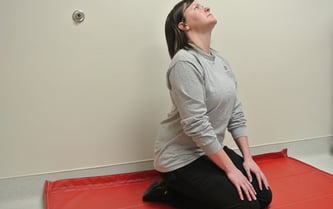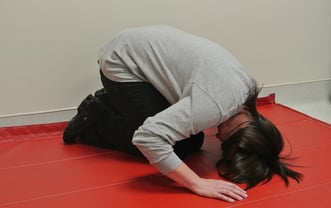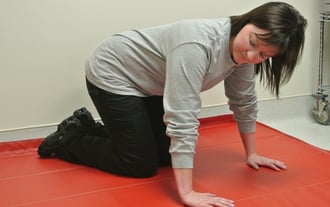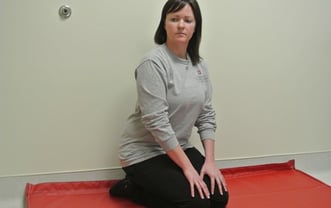When Carol Foster, associate professor at the CU School of Medicine, started experiencing bouts of vicious dizziness and accompanying nausea, she was stunned—not because she didn’t know what was happening, but because this disease was so much more severe than she had ever realized, even as a practicing physician. In her case, the attacks hit her almost every day.

Carol Foster, MD had Meniere’s Disease, a disorder of the inner ear that causes bouts of vertigo that can last for hours.
But instead of crumbling, she decided to fight back.
“I decided that [Meniere’s Disease] was a worthy foe,” Foster said. “I would make it my mission to destroy something that was worth working on.”
So Foster returned to school with a National Institutes of Health fellowship in neuro-otology at the University of California, Los Angeles Medical Center. In her late 30s, she had surgery to cut the nerve to the ear that was triggering the disease. Her bouts of vertigo stopped immediately—until one morning, 14 years later, when she rolled over in bed and felt the room start to spin and the first wave of nausea. Her first thought was that she could not miss work.
“I had to go in because these other sick people were waiting for me,” she said.
As a scientist and physician, she knew immediately that this time, the vertigo was not triggered by Meniere’s Disease, but by something different—something she might be able to fix herself.
Half-somersault Maneuver (right ear)
Step-by-step instructions on how to treat vertigo:
Step1:

Step 2:

Step 3:

Step 4:

Step 5:

Benign paroxysmal positional vertigo (BPPV)
More than 7 million people in the United States can expect to have benign paroxysmal positional vertigo (BPPV), especially as they age. Unlike Meniere’s Disease, where the cause is often unknown, BPPV is caused by gravity-sensing particles in the ear accidentally entering the spinning-motion sensors of the ear. The symptoms of BPPV can be relieved by maneuvers that relocate the particles.
That morning in her bedroom, Foster, whose practice included patients with exactly the problem she was experiencing, knew this was about of BPPV in her “good” ear, the one not affected by Meniere’s Disease. While the room spun around her, and she became increasingly sicker, she gave cool consideration to her options.
“I had already spent so many years having vertigo, it had become a science experiment,” she said. “I was a trained scientist running across a rare specimen, and the specimen was me.”
In her bedroom, Foster tried a maneuver on herself that she had often done on patients—the Epley, a series of body and head maneuvers used to treat BPPV, most often done by a medical professional treating a patient. The particles moved out of her ear canals and then slipped right back into the horizontal canal. The vertigo intensified.
“I was starting to get very sick,” said Foster. “Then I thought to myself, ‘There’s more than one way to skin a cat.’”
The Foster Maneuver
With the room spinning around her, Foster made a model of the ear with her fingers and tilting and turning the model in front of her eyes, she began to conceive a maneuver that might get the particles out of her horizontal canal and back where they belonged.
Then, she translated the theory she had created with her finger model into action, with a half-somersault, followed by a head turn and another quick move of the head.
“Bing! It was gone,” said Foster. “The second those particles moved out, the spinning just dead stopped.”
A moment later, Foster realized the implications of what she had discovered. This was instant relief from a terribly disabling experience that a patient could do at home, alone—and for free.
“I have seen patients admitted with horrible vomiting, just because they have particles lodged in the wrong canal,” said Foster. “We do a $5,000 work-up on them only to figure out that this could be relieved in a second by a simple maneuver.”
Going Insane No More
But don’t be too concerned that Foster might put herself out of business. After she decided to entertain media attention for her maneuver (“If you had an off-switch for cancer, you wouldn’t hide it!”), she has watched her practice expand dramatically.
Some patients suffering from BPPV come in holding the diagram for the Foster maneuver in their hands to check they are doing it correctly. “They just don’t believe it can be that simple,” Foster said.
Other patients still have not heard about the maneuver. Still others come in because they have tried it and don’t think it works. Foster has to explain to them that it’s ear specific. There’s a right way and a left way. Do the wrong ear, and it won’t work.
Every patient for whom it works loves it, some even more than others. Foster remembers one 40-year-old woman who thought vertigo was a form of insanity.
“Having vertigo was such a big part of her life, she thought she was losing her mind,” Foster said about the woman’s condition. Once she learned the maneuver, she became “a very happy camper,” said Foster.
Foster used the Half-somersault Maneuver several times after that first attack, until she discovered that sleeping with her head slightly elevated at night prevented the particles from slipping into the wrong part of the ear. Now she tells patients to try the pillow trick and avoid exercises or yoga where they would put their heads upside down.
Following her own advice, Foster is also a happy camper. “I haven’t had another spell in four years.”




